Men’s dress shirts come in various styles, with many fun colors, cuts, and accents to choose from. One of the most subtle style differences in dress shirts is the use of buttons. When you compare button-up vs button-down shirts, what exactly is the difference?
The biggest difference between a button-up and a button-down shirt is that a button-down shirt has buttons to hold the collar down. A button-up shirt has buttons at the center front of the shirt from the neckline down to the hem. A button-down shirt has buttons down the center front of the shirt, but it also has two buttons to hold the collar in place.
In this article, you will learn the common characteristics of a button-up and a button-down shirt. You will find out the key differences between the two popular styles of dress shirts. Finally, you will discover essential tips on how to style both kinds of shirts!
Quick Navigation
- Button Up vs Button Down Shirts: Key Points
- What is a Button Up Shirt?
- What is a Button Down Shirt?
- What is the Difference Between Button Up and Button Down Shirts?
- Is a Polo Shirt a Button Down?
- Button-Up Shirts for Men
- Are Button-Up Shirts in Style?
- Can You Wear a Button-Up Shirt Without a Tie?
- Can You Wear a Button-Down Shirt Unbuttoned?
- How Should You Wear a Button Up or Button Down Shirt with a Suit?
- Conclusion
Button Up vs Button Down Shirts: Key Points
| Button up | Button down | |
|---|---|---|
| Buttons | Buttons run in a straight line from the hem of the shirt to the neck. | Buttons run in a straight line from the hem of the shirt to the neck, but this style also features buttons at the corners of the collar. |
| Cut | Varying cuts in the body of the shirt, as well as over fourteen different collar options. | Varying cuts in the body of the shirt, but most often features a shape of a collar called the button-down collar. |
| Formal or Informal | Usually more formal, featuring a stiffer collar. | Usually less formal, featuring a more relaxed collar held in place with buttons. |
| Type of Material | The kind of cloth varies greatly but this style usually features white or light colors. | The kind of cloth varies greatly, but this style of shirt often features darker colors. |
| Cost | Depends on the brand of the shirt. | Depends on the brand of the shirt. |
| Best Used For | Formal or business-casual wear. | Business casual or informal occassions. |
What is a Button Up Shirt?
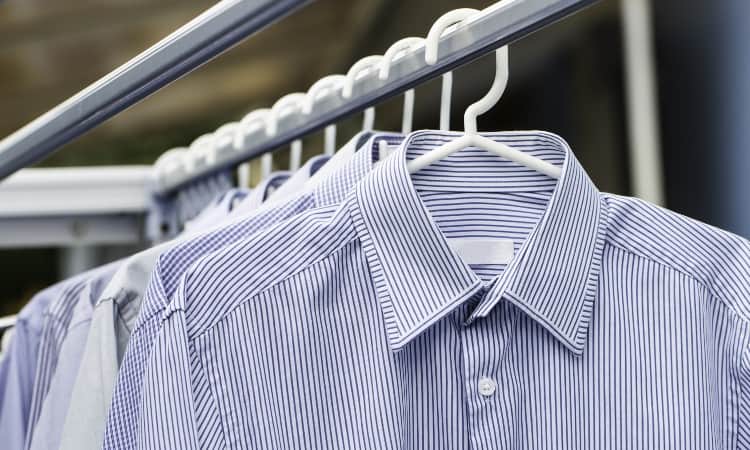
A button-up shirt has a row of buttons running up the center front of the shirt, from the hem to the opening at the neck hole. This shirt style has many names, including dress shirts and button-front shirts. You almost certainly own several of these popular shirts, which remain one of the most commonly worn men’s shirt styles in the world.
Button-up shirts work well paired with a suit or worn without a jacket with a pair of khakis. This shirt often comes in a simple white or light-colored shade of fabric, though, of course, you can find many style variations in cut and color as well!
The classic button-up shirt typically features a rather rectangular cut with a box pleat at the center back to provide ease of movement. But these days, you can also get more tailored cuts such as an athletic cut or a fitted cut with a more narrow design to fit different shapes and sizes of bodies.
Interestingly, the button-up shirt marks one of the first times in fashion history that men could wear shirts as an outer garment rather than as an undergarment beneath a jacket, vest, or other item of clothing. Men have worn shirts for hundreds or thousands of years, mind you! But these garments typically featured a pull-on style and required a more culturally accepted covering ranging from a toga to a doublet to a jacket when a man appeared in public.
In the 18th century, all of this began to change, largely because of the Industrial Revolution and the new way machines could make clothing. The first button-up shirt as we know it today has a patent registered in the 1870s. It quickly became the most common style of shirt for professional men to wear to work, often paired with a blazer or suit jacket.
To this day, one of the most popular styles of button-up shirts features a crisp white fabric. This trend reaches way back into the depths of history because wearing white clothes that require constant laundering has often served as a symbol of wealth!
One key thing to know about button-up shirts is their universal appeal. You can wear them in almost any situation. This shirt works equally well when worn with a suit and tie or open at the throat with a pair of jeans!
What is a Button Down Shirt?
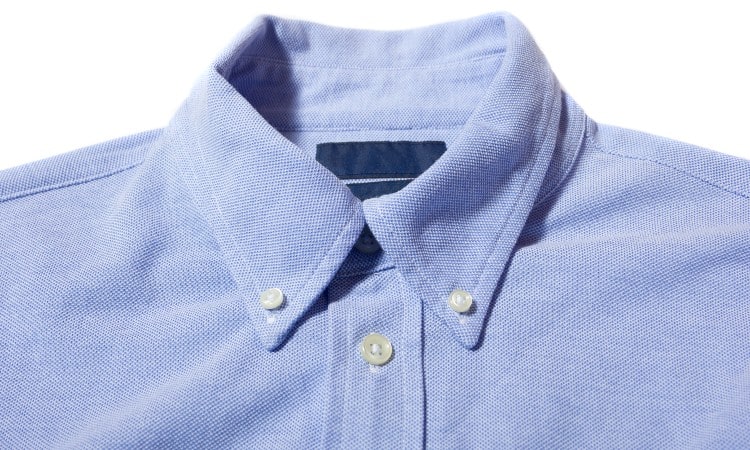
A button-down shirt also features buttons all the way up the center front of the shirt, but it must also have buttons on the triangular point of the collar, holding the collar to the shirt. So a button-down shirt is a kind of button-up shirt, but it has the additional feature of the collar buttons.
People have worn button-up shirts for quite a long time in the history of fashion, but the addition of the two small buttons on the collar corners occurred more recently.
Credit for the invention of the collar buttons goes to polo players in England sometime around the late 1800s. These athletes often found that their shirt collars would flap up distractingly as they dashed around fast polo ponies during a game. To solve the problem, they began adding buttons and pins to hold the shirt collars down during a match!
Fashion history claims that a tailor named John Brooks implemented the collar buttons after visiting England. He marketed the new style to American athletes, but the collar buttons quickly gained popularity. You probably know this name, as he founded the famous Brooks Brothers company!
By today, of course, you see button-down shirts everywhere, from the office to the sidelines of a football game.
That said, button-down shirts traditionally have a slightly less formal appearance than your average button-up shirt, possibly because this style has its roots in the athletic world. These shirts sometimes have more of a preppy look than a button-up shirt, too.
What is the Difference Between Button Up and Button Down Shirts?
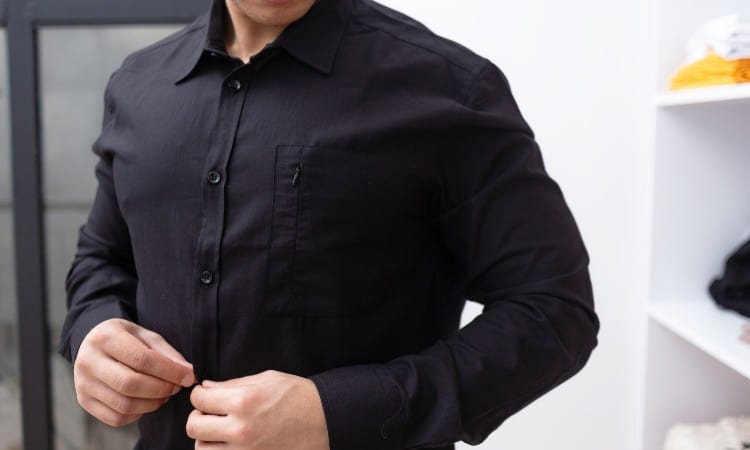
The main difference between button-up and button-down shirts is that both styles feature buttons all the way up the front, but button-down styles also include buttons on the points of the collar.
One easy way to remember the distinction between the two styles of shirts is to remind yourself that a button-up shirt buttons up the front of the shirt all the way to the top, and a button-down shirt has a collar that buttons down to the shirt.
This is the only main difference between the two styles of shirts, but you will find that each style has subtle differences in factors, such as the color of fabric used and the formality associated with it as well.
It is worth noting that button-up shirts for women remain extremely popular, but women’s fashion does not often feature a button-down style with collar buttons. This is probably because, back in the day, women did not play polo! It may also reflect the stylistic difference that women do not wear ties with formal shirts as often as men do in today’s fashion.
Despite this, you will often see the terms “button up” and button down” used interchangeably to describe any women’s shirt with a full row of buttons.
Buttons
The key difference between a button-up and a button-down shirt is that a button-down shirt features buttons at the corner of the collar, fastening the collar to the shirt.
Most button-up and button-down shirts use small round buttons measuring between 13 to 15 mm across. The most common kind of shirt buttons contains plastic or resin, though you do still see some more traditional mother-of-pearl or horn buttons on bespoke shirts.
An important stylistic note is that if you choose to wear a button-down shirt, you should always fasten the collar buttons, holding the collar neatly in place to the shirt. This holds true whether or not you wear a tie with the shirt.
Cut
Both button-up and button-down shirts can have a variety of cuts, but button-down shirts most often feature a special shape of a collar called the button-down collar.
Button-up vs button-down shirts do not typically have any major differences in the cut or shape body of the shirt, though. You can buy both types of shirts in a wide range of cuts from most shirt brands.
Generally speaking, more fitted styles look more modern and can also look more formal. Looser styles of shirts, such as the traditional or classic cut, can look a bit old-fashioned or more casual.
The shape and size of the collars used on both types of shirts can vary a lot as well. Most button-down shirts feature (surprise!) a style of a collar called the button-down collar. This is not always the case, though, as you can find those characteristic corner buttons on other styles of collars, such as the hidden button collar, the tab collar, or the point collar.
Button-up shirts can feature a wide range of collar shapes, including the cut-away spread collar, the eyelet collar, the varsity collar, or even the less formal band collar. Modern dress shirts can feature over fourteen common collar styles!
Formal or Informal
Most of the time, a button-up shirt has a more formal appearance than a button-down. This is not to say that you can’t wear a button-down under a suit jacket or with a tie, because you certainly can! But button-up shirts can feature a stiffer collar that looks more formal, while button-downs often have a slightly softer collar held in place by the corner buttons.
For example, one of the most popular styles of button-down shirts is the Oxford shirt. This shirt always features a pale blue striped material and a white button-down collar. It has a semi-formal appearance, and you would not want to wear it with a tuxedo jacket!
In contrast, a classic white button-down with sharp lines and a starched collar can work when paired with even the most formal suit jacket and tie.
Type of Material
The main difference in the type of material used in button-up vs button-down shirts is that button-up shirts often feature lighter colors, while button-downs may include a range of darker colors of fabric.
Both button-up and button-down shirts can feature many types of material, ranging from cheaper polyester to pricier cotton, linen, lawn, or even fabric containing a blend of fibers with silk woven in.
You often see a difference in the color of the cloth used in two different styles of shirt, though. The most common color for a button-up shirt is a crisp white or a pale shade like cream or pink. These sharply defined, light colors pair well with formal suits and tend to give the button-up an overall more formal appearance.
Button-down shirts come in these muted shades, but you can also find them in less formal, darker colors.
This raises an interesting question: can a dress shirt come n less-formal fabrics like denim or flannel? Well, yes and no.
If your workplace asks you to wear a button-up shirt, fashion rules typically imply that this means a formal white or light-colored shirt with buttons up the front and probably a starched collar rather than a button-down collar.
Technically, a classic denim or flannel shirt does have the same cut and button style as a button-up shirt. But these styles remain popular in less formal settings, while the traditional button-up is more appropriate for the workplace or to wear with a suit.
Cost
There is no significant difference in cost between a button-up and a button-down shirt. That said, you can certainly find a huge range in price in these shirts, depending on what brand you choose.
For example, ordering a custom-made dress shirt can cost anywhere from about $150 to $500 per shirt. But you can buy an off-the-rack dress shirt at most department stores for under $50!
This wide price variation even occurs if you pick a specific subcategory of a shirt, like an Oxford style. You can find Oxford-style shirts made from polyester that cost as little as $40. But if you buy a shirt from a more prominent brand name, an Oxford can easily set you back by as much as $275!
Best Used For
You can wear both a button-up and a button-down shirt for any business casual or semi-formal occasion. A button-up works better for formal events like interviews and weddings. A button-down works best for less formal events like teaching in a college classroom or wearing beneath a sports blazer.
Of course, neither shirt style is super casual, so you probably would not wear these dress shirts to a cookout or the local bar!
Is a Polo Shirt a Button Down?
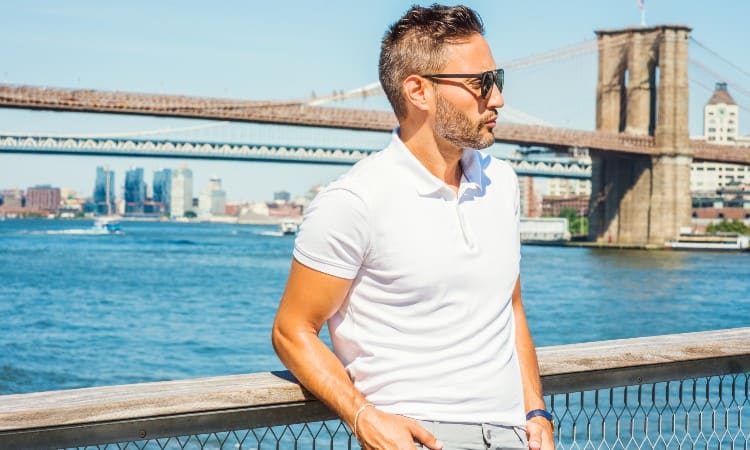
A polo shirt is not exactly a button-down shirt, though it does feature a button-down collar. Polo shirts have a button placket at the neck but do not have buttons all the way up the front of the shirt. This stylistic difference sets them apart from both button-up and button-down styles.
This is a bit confusing because this kind of collar originated on polo shirts! In fact, for a long time, tailors called button-down collars “polo collars” because of this.
But polo shirts typically have a less formal appearance than either button-up or button-down shirts, because polo shirts feature short sleeves and a stretchier knit jersey or cotton pique fabric. For some reason, more comfortable clothes always get classified as less formal!
If you want a less formal shirt to wear to an outdoor work event, though, you could safely choose a polo shirt for the event. Or you could wear a button-down shirt with the top two buttons undone and your sleeves rolled up.
Button-Up Shirts for Men
 You can find button-up shirts for men from almost any clothing line selling shirts! These examples will give you an idea of the key characteristics you will see when you shop for a button-up shirt.
You can find button-up shirts for men from almost any clothing line selling shirts! These examples will give you an idea of the key characteristics you will see when you shop for a button-up shirt.
This Calvin Kelin dress shirt contains crisp white cotton in a herringbone weave in a fitted button-up style. For added formality, the shirt features a starched collar that you can wear open at the neck or buttoned close when paired with a tie. While Calvin Klein offers a lot of different button-up shirt styles, this white shirt has the added fancy touch of French cuffs to give you an elegant appearance.
This Lacoste Oxford-style shirt gives you a clear idea of the classic button-down shirt in contrast. It features a soft collar with two tiny buttons at each collar point. Based on the athletic principles of the Lacoste brand, this shirt features a relaxed fit for ease of movement.
Are Button-Up Shirts in Style?
Button-up shirts remain a popular style choice for both men and women. For men, the button-up remains the shirt of choice for the office or workplace and most formal events.
But even the world of pop culture continues to embrace the button-up! For example, you can commonly see movie stars and fashion icons wearing a button-up unbuttoned and tied into a crop top. Another popular trend for both men and women is to wear a dress shirt unbuttoned over a vintage tee.
The fact of the matter is that the classic button-up has remained in style since the beginning of the 20th century. It does not seem likely to go away any time soon!
Can You Wear a Button-Up Shirt Without a Tie?
You can wear a button-up shirt without a tie, though this style looks less formal. Generally speaking, you should unbutton the top two buttons at the neck when you forego a tie. (After all, what is the point of taking off a constraining tie if you don’t also undo the top buttons to give yourself more breathing room?).
That said, there is a modern style trend to wear a button-up shirt fastened all the way to the throat without a tie. You see this often during the fall and winter months in a business-casual setting.
You can wear most button-down shirts unbuttoned to present a laid-back, much more casual appearance.
You can wear a button-down shirt unbuttoned in two popular ways. First, you can unfasten all but two of the buttons, usually in the middle of the shirt. Second, you can entirely open the shirt.
Either way, you will want to wear a t-shirt underneath! You can go with a plain undershirt or add an even more casual vibe by wearing an unbuttoned shirt open over a printed tee.
The open shirt style does look best with a looser, less fitted button-down shirt, though. Plus, it can look more appropriate if you choose an informal fabric style, such as a linen or cotton shirt with a checked pattern.
How Should You Wear a Button Up or Button Down Shirt with a Suit?
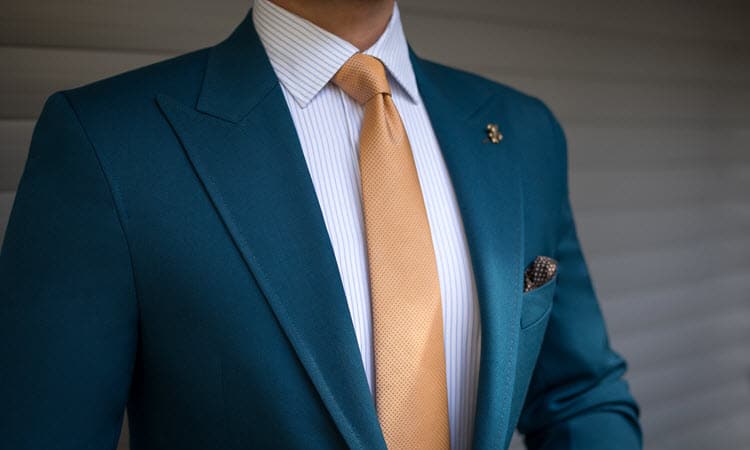
You can wear both a button-up and a button-down shirt with a suit, though each style of shirt works best with certain types of outfits.
Check out these style tips to help you decide how to wear either a button-up or button-down shirt with a suit:
- Many button-down shirts, such as an Oxford style, look great when paired with less formal unmatched blazers and slacks combos. For example, you might match a classic blue Oxford with a button-down collar with grey slacks and a navy sports jacket.
- For a more formal appearance, make sure you select a button-up shirt with a stiffened collar to go with a two-piece suit. Do not select a shirt in the same color as the suit, keeping in mind the general rule of thumb that white shirts have the most classic, formal appearance.
- When choosing a shirt to go with a suit, make sure it has a fitted cut that will not bag out and make the suit jacket look puffy. This holds true whether you pick a button-up or button-down shirt!
- This fashion “rule” can fluctuate depending on the formality of the setting. But the classic guide is that you should wear any shirt with a pointed collar with a tie.
- You probably know this, but you should never button the lowest button on your suit jacket. Also, always unbutton the jacket when you sit to avoid ruining the lines of your jacket!
Conclusion
The biggest difference between a button-up and a button-down shirt is that a button-down shirt features buttons at the corner of the collar. Both types of shirts have a row of buttons running all the way up the center front of the shirt. Both types of shirts can feature a variety of cuts, such as a tailored fit or an athletic fit, but button-up shirts can have a wider range of collar styles.
Generally, button-up shirts have a more formal appearance than button-down shirts, because button-up shirts often have stiffer collars than button-down shirts. Plus, button-up shirts often come in traditional white fabric fabrics, while button-down shirts may feature darker colors.